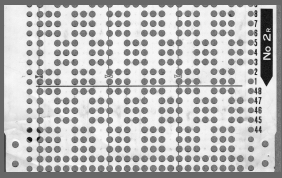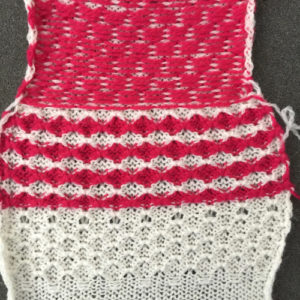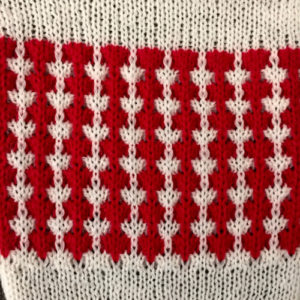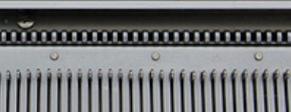I touched on knitting with 2 carriages in some previous posts:
2011/03/30/knitting-with-2-carriages/
2011/03/29/lace-meets-hold-and-goes-round/
2015/03/31/combining-tuck-stitches-with-lace-2-automating-them/
If 2 carriages are in use for patterning extension rails are a must. For this discussion we are excluding the lace carriage as the #2, the intent is to use 2 knit carriages with each set to desired cam functions. As one carriage is put to rest and the other one is set to move from the opposite side, the card does not advance, so the last row selected is repeated one more time. In one of those lightbulb moments today (any excuse not to do laundry) it occurred to me that starting out with an odd number repeat pre-punched card, coming from the opposite direction at the end of each odd row repeat, an even-numbered repeat would actually be knit. The card below is a Brother issue with all standard knitting machines. Card number (2 in this instance) may vary, depending on the year of purchase. Color changes here as well would have to be planned for every even number of rows, so respective carriages can travel to and from each side.
The swatch below begins with locked selection row on punchcard row marked #1 (standard location); tuck setting is used in first 2 segments, FI on third; pattern produced is “OK”, but not actually tucking for 4 consecutive rows; note how much narrower FI is than tuck. Tuck tends to be short and fat, slip and fair isle short and skinny when compared to plain knit in same yarns 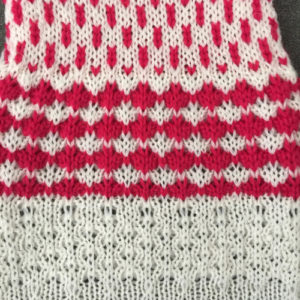
Since Brother preselects for the next row of knitting, setting the first selection row one locked below the usual spot on in this case #48 got me what I wanted, each color now tucking for 4 rows
Then something a bit more exciting occurred to me; one is an odd number, so any card where single rows are punched could be executed in theory, changing color every 2 rows (remembering to start with first selection row one row below # 1-row mark on the card). This sample was knit with 2 carriages, using a maze card, illustrated in a previous post, in which each row had been punched only one time, requiring for the repeat to be elongated X2 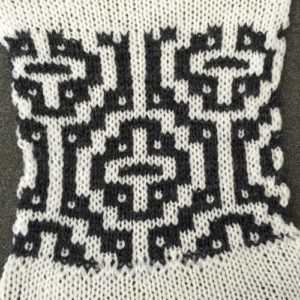
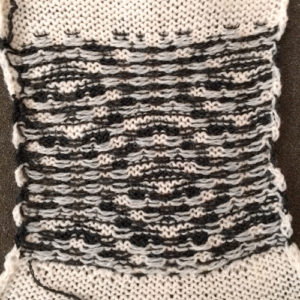
the image from the previous post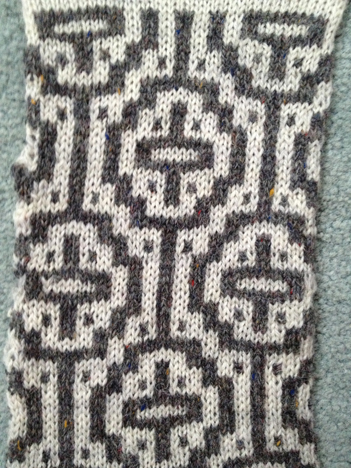
Using 2 carriages allows for combining yarns using different tensions, cam settings, fiber content, or sometimes using materials that the single bed color changer is not “friendly” with. Also, there is no pushing the wrong button, causing errors in sequence, or dropped knitting if no yarn is picked up.
A punchcard carriage may be used on electronic machines. I work on a KH892, and a 910. The 910 is from a much earlier model year than the punchcard machine. The back rail for the KH to travel on, is a different shape, with slits as opposed to smooth, and a bit more raised. The electronic carriage set on KC locks on the belt and advances the card appropriately, but the fit is quite snug, making it hard to push, while the 892 behaved well on the 910. If borrowing carriages and sinker plates from different model years or one type of machine to use on another, proceed with caution and listen to your machine. Sometimes the span of time between model issues is irrelevant, even if model years are only a year apart, and the swap is not the best for successful knitting, may “work” in one direction, but not as well in the other.
Dec 7, 2018 Knitting studio simple lace with 2 lace carriages transferring stitches
